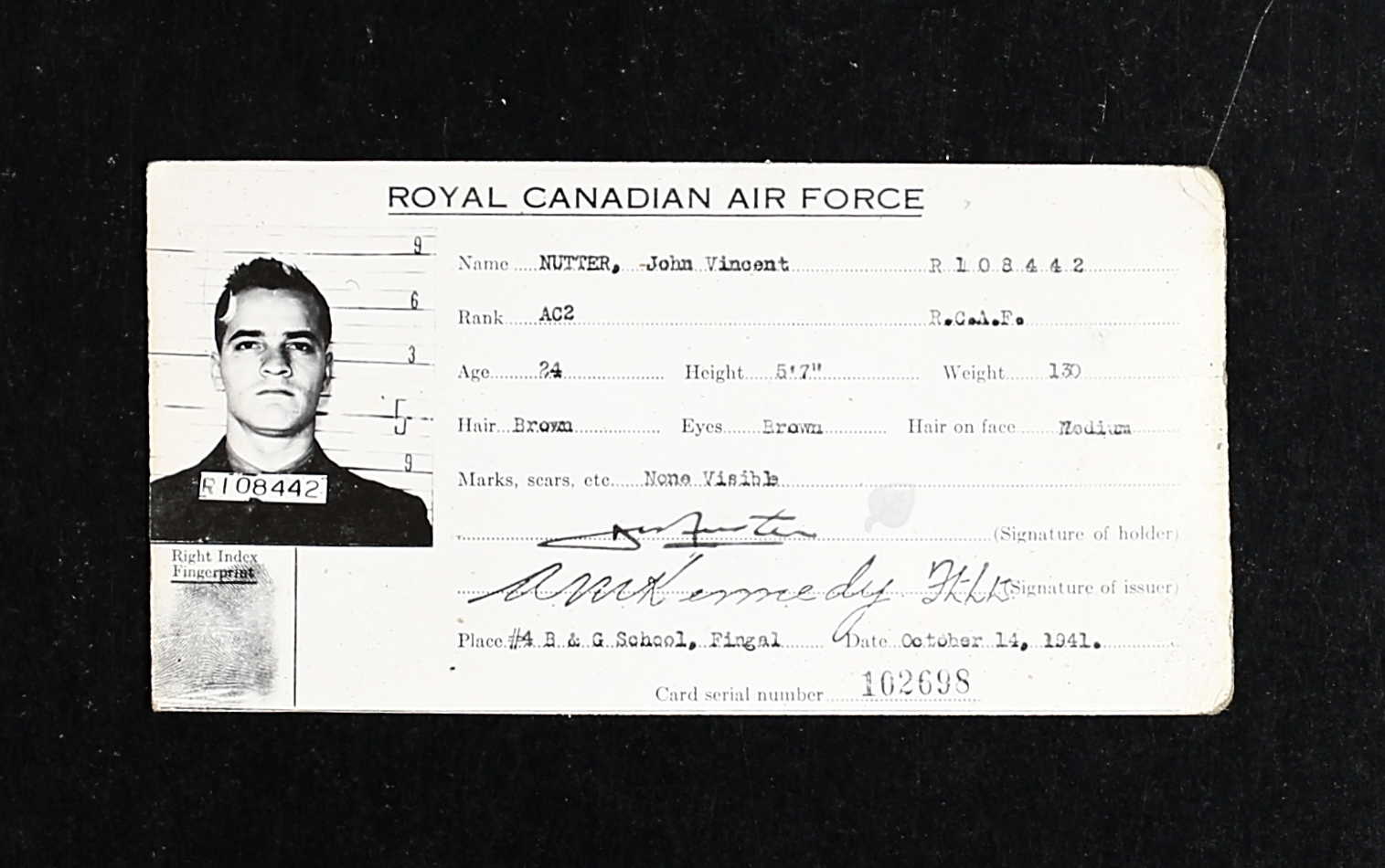
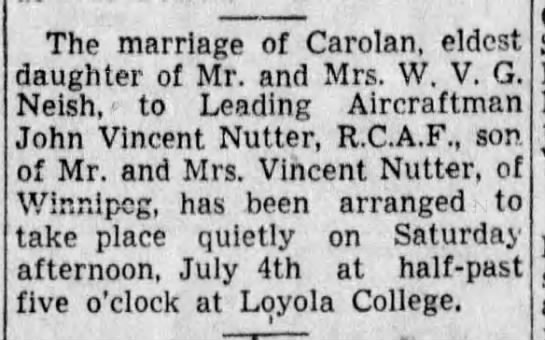

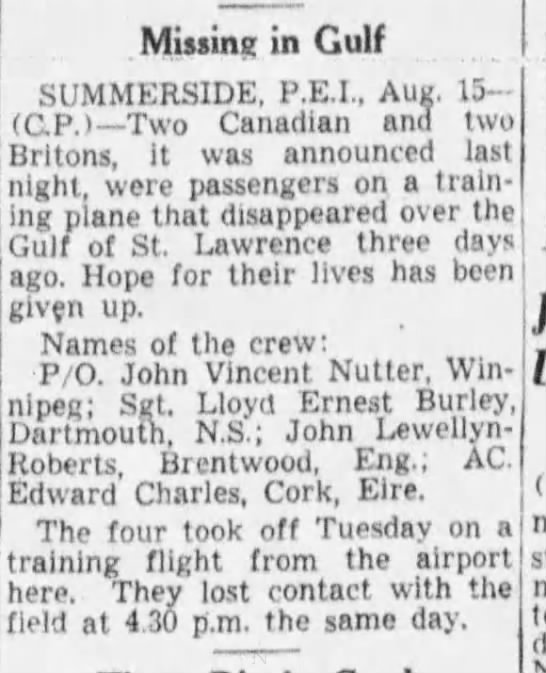

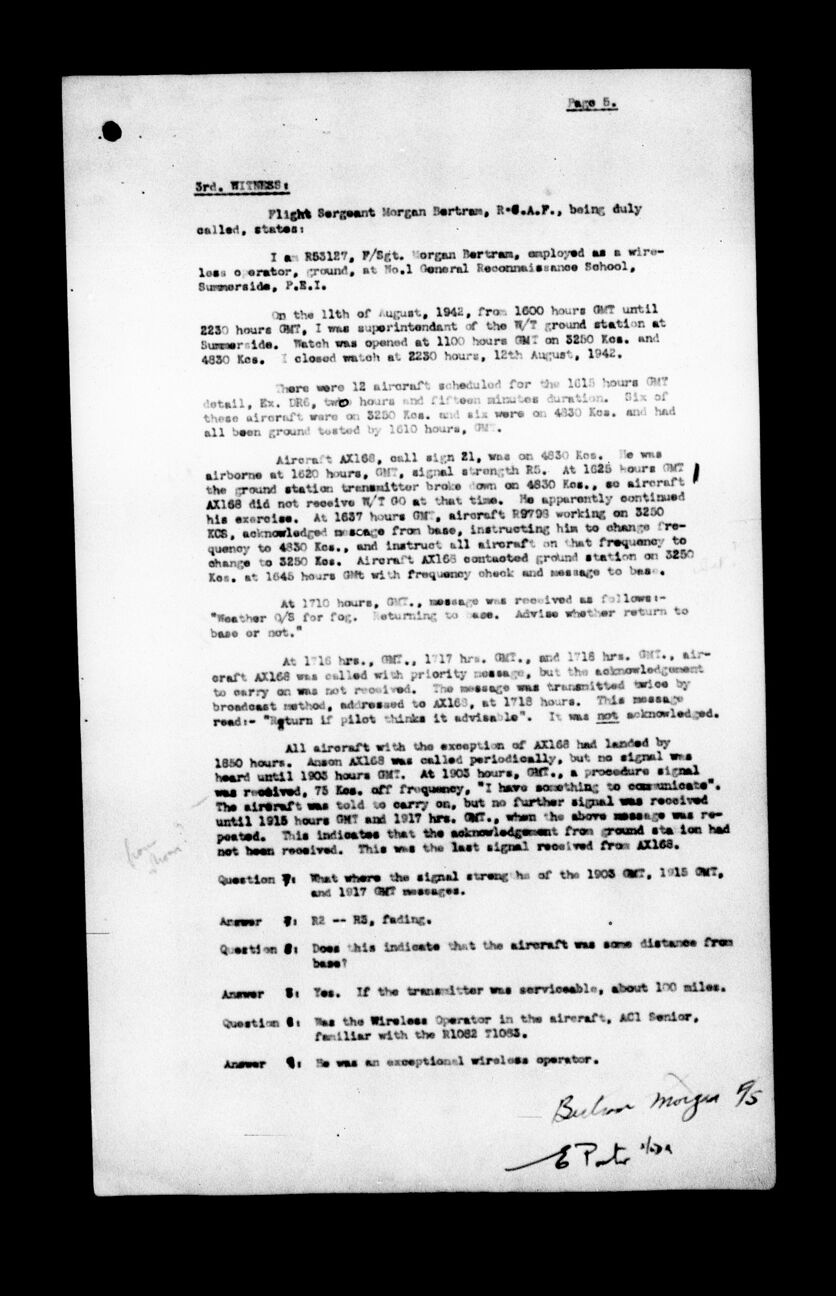

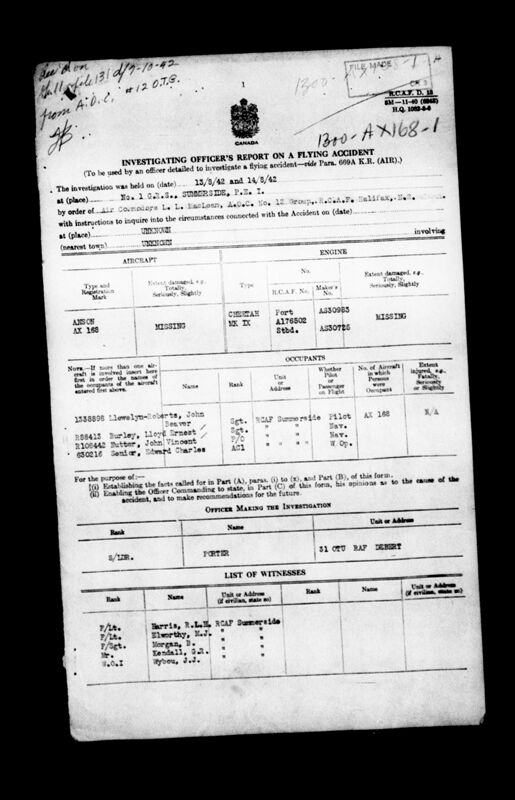
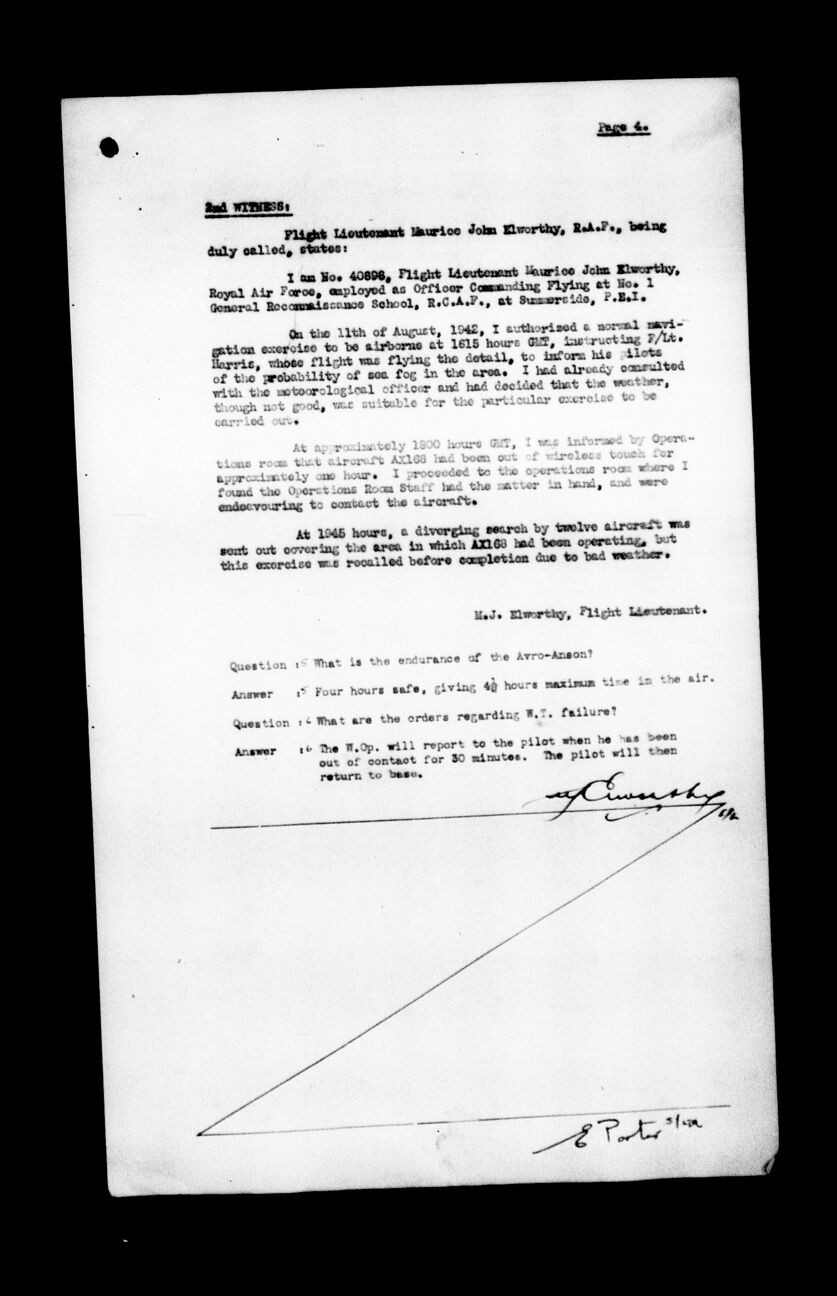
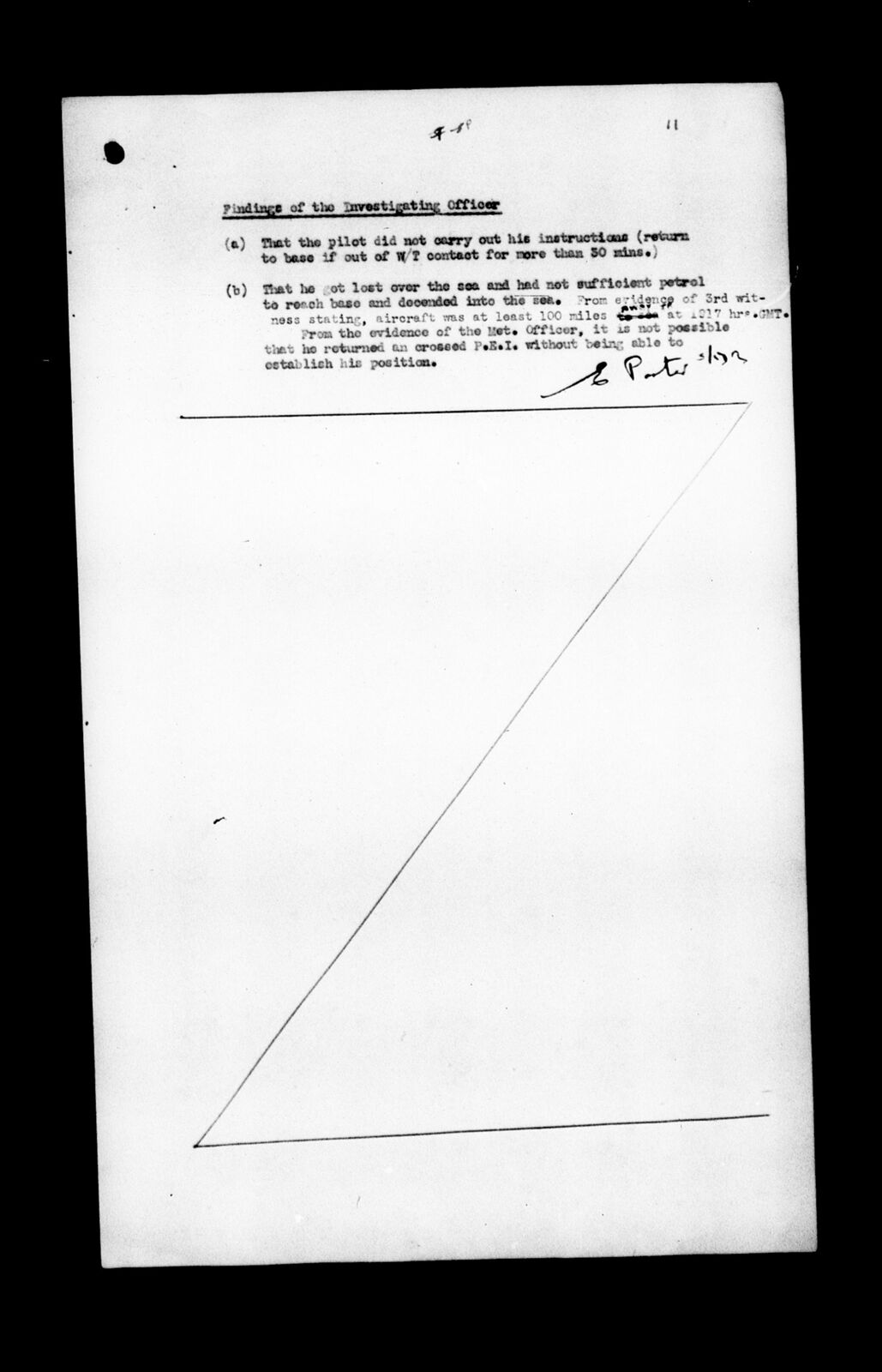
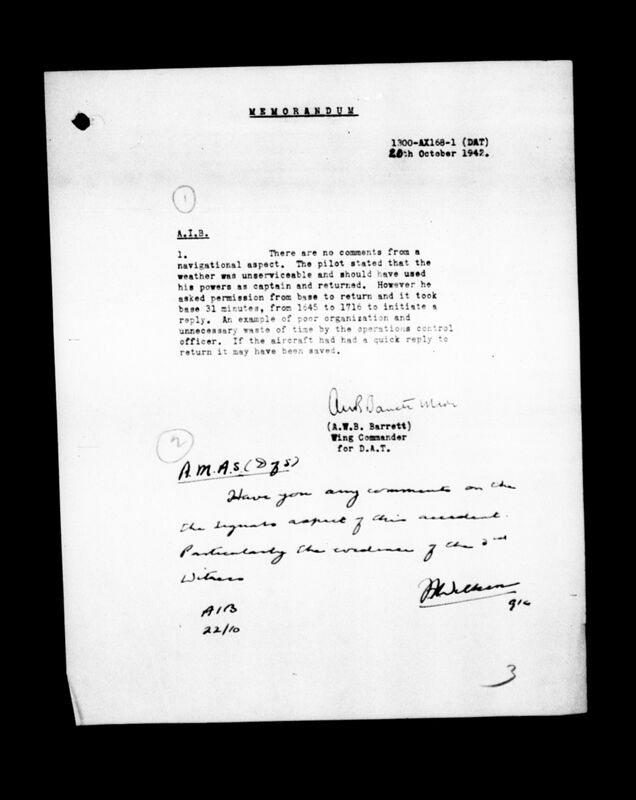
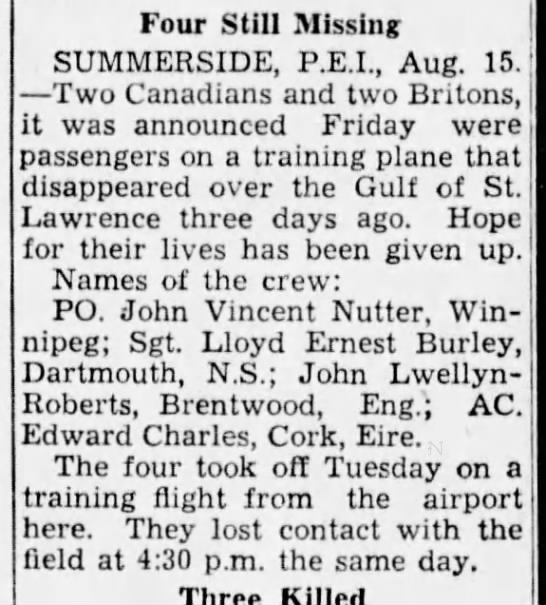
November 5, 1917 - August 11, 1942












John Vincent Nutter was the son of John Vincent Nutter, Sr., insurance broker, and Elizabeth (nee Anderson) Nutter of Winnipeg, Manitoba. He had two sisters: Betty and Jean.
John was a clerk for 18 months, then a department manager for six months; for another six months, he was an insurance underwriter. He had two years of Engineering but did not complete his studies. John applied to the RCAF in late 1939 and he reapplied in June 1941. He said he had some debt involving various bills but would be clear in two months. [At the time of his death, he owed $59 to Top Notch Clothes for his uniforms.] He “understood and am interested in internal combustion motors.” He also wrote, “Used to buy old automobiles to convert them into ‘bugs’ as a hobby.”
John lived in Winnipeg until 1936, then moved to Montreal.
John stood 5’7” tall and weighed 130 pounds. He had brown eyes and brown hair, with a medium complexion. He liked to ski and swim. “I should like to be medically examined and have other formalities completed in near future, but would not like to be called up until August 11, 1941.” John indicated he had abscesses in both ear canals in 1939, had an appendectomy and herniotomy in 1936, plus his tonsils removed in 1930. He smoked ¼ pound weekly pipe, and drank alcohol occasionally. “Good physique; intelligence and alertness above average. Initiative, responsibility, emotional stability above average.” Other comments: “Slight concussion at 8 years. 10 pounds underweight. Ocular muscle balance is borderline. In Bishop Harman test, there was some crowding at the ends of the line of numbers, the significance of which is not understood. The main ocular muscle unbalance appears to be moderate exophoria and borderline hyperphoria.”
John’s journey through the BCATP began at the Montreal recruiting centre July 7, 1941. From there, he was sent to No. 1 Manning Depot Toronto, August 18, 1941.
Fingal, Ontario and No. 5 B&G School was his next stop from August 21 to October 27, 1941.
From there, he returned to Toronto and No. 6 ITS for seven weeks. He was first in his class of 92 with a 97.4%. “Alert, enthusiastic, co-operative type. Excellent educational and executive background. Shows leadership qualities. Commission material. Second aircrew recommendation: Air Gunner.” He was recommended to be a Pilot first.
From there, he went to No. 7 EFTS, Windsor, Ontario, December 21, 1941 to March 14, 1942. “Co-ordination good. Instrument average. Eager to learn. Good discipline. No outstanding faults. Good service type. Good in Link.” GROUND TRAINING: First in class of 33 with 79.3%. A good student with plenty of pep and go. Class conduct good. Easy going and confident.”
Aylmer, Ontario and No. 14 SFTS March 15 until July 24, 1942. He trained with Lloyd Ernest Burley. Like Lloyd, he received the ‘First Aid to the Injured’ certificate. “Navigation Link: Exceptional. Prefers fighters. Reconnaissance bombers. Very keen and enthusiastic. Easy going, confident. GROUND TRAINING: A keen progressive enthusiastic student who did exceptionally well throughout his course.” He was commissioned July 3, 1942.
He married Carolan Marie Neish (1921-1999) on July 4, 1942 in Montreal, Quebec.
On July 24, 1942, John was sent to No. 1 GRS for further training. Lloyd Burley joined him in Summerside, PEI.
Less than two months later, they were missing over the Gulf of St. Lawrence with two others aboard Anson AX168: Sgt. John Beaver Llewelyn-Roberts, 1338898, RAF, and LAC Edward Charles Robert Senior, 630216, RAF. “At Summerside, visibility 15 miles, scattered clouds at 1500 feet; unlimited overcast. Overcast with patches of sea fog over Gulf [of St. Lawrence]. Aircraft failed to return from routine navigation exercise over Gulf of St. Lawrence.”
Llewelyn-Roberts was noted as the pilot with Burley was first navigator and Nutter as second navigator. Senior was the wireless operator.
S/L Porter from No. 31 O.T.U. was the officer in charge of the investigation. Five witnesses were called on August 13-14, 1942, resuming on August 26, 1942.
The first witness, F/L R. L. H. Harris, 70901, Flight Commander of A Flight, No 1 GRS, Summerside, PEI: “On the 11th of August 1942, Sgt. Llewelyn-Roberts, a staff pilot and crew under instruction, were detailed on the programme to carry out a routine navigation training flight in Anson AX168, taking off at 1615 hours and returning to Summerside at approximately 1930 hours. He took off at 1615 hours. At 1800 hours, I was informed that no sign had been received from this aircraft for one hour. The aircraft failed to return and the G/C flying took overdue action.” He said that the airplane had been flown the previous day without issue and all flying instruments were serviceable, as the pilot had flown Anson AX168 “since he came here on the 17th of July 1942. His ability as pilot was average and has on previous occasions, avoided flying in bad weather.”
The second witness, F/L Maurice John Elworthy, 40898, RAF: “On the 11th of August 1942, I authorized a normal navigation exercise to be airborne at 1615 hours, instructing F/L Harris, whose flight was flying the detail, to inform his pilots of the probability of some fog in the area. I had already consulted with the meteorological officer and had decided that the weather, though not good, was suitable for the particular exercise to be carried out. At approximately 1800 hours, I was informed by Operations room that aircraft AX168 had been out of wireless touch for approximately one hour. I proceeded to the operational room where I found the Operations Room Staff had the matter at hand and were endeavouring to contact the aircraft. At 1945, a diverging search by twelve aircraft was sent out covering the area in which AX168 had been operating, but this exercise was recalled before completion due to bad weather.” He indicated that the endurance of the Avro-Anson was four hours safe, giving 4.5 hours maximum time in the air. If the W. T. failed, the wireless operator was to report to the pilot when he was out of contact for 30 minutes. The pilot was then to return to base.
The third witness, F/S Morgan Bertram, R53127, wireless operator, ground, No. 1 G. R. S.: “There were twelve aircraft scheduled for the 1615 hours detail, for two hours and 15 minutes’ duration…Aircraft AX168, call sign 21, was on 4830 Kcs. He was airborne at 1620 hours, signal strength R5. At 1625 hours, the ground station transmitter broke down…so aircraft AX168 did not receive W/T GO at that time. He apparently continued his exercise. At 1637, aircraft R9798…acknowledged message from base, instructing him to change frequency and instruct all aircraft on that frequency to change….aircraft AX168 contacted ground station at 1645 hours with frequency check and message to base. At 1710, message was received: ‘Weather O/S for fog. Returning to base. Advise whether return to base or not.” At 1716, 1717, 1718, aircraft AX168 was called with priority message, but the acknowledgement to carry on was not received. The message was transmitted twice by broadcast method, addressed to AX168 at 1718 hours. This message read: ‘Return if pilot thinks it advisable.’ It was NOT acknowledged. All aircraft with the exception of AX168 had landed by 1850 hours. Anson AX168 was called periodically, but no signal was heard until 1903 hours. At 1903 hours, a procedure signal was received…’I have something to communicate.’ The aircraft was told to carry on but no further signal was received until 1916 hours and 1917 hours when the above message was repeated. This indicates that the acknowledgement from ground station had not been received. This is the last signal received from AX168.” He said that the message received indicated that the aircraft was some distance from base, about 100 miles. “Wireless Operator Senior was an exceptional wireless operator. It is possible that he sent had gone unserviceable in the air and that he had been working on it.”
The fourth witness, Mr. George Roland Kendall, meteorologist; “Fog patches onto the water, visibility under half a mile, intermittent rain and drizzle.”
FINDINGS: That the pilot did not carry out his instructions (return to base if out of W/T contact for more than 30 minutes). That he got lost over the sea and had not sufficient petrol to reach base and descended into the sea. From the evidence of the 3rd witness, the aircraft was at least 100 miles away at 1917 hours. From the evidence of the met. officer, it is not possible that he returned and crossed PEI without being able to establish his position. Anson AX168 had broken W/T for one hours 53 minutes.
The pilot had approximately 100 hours as staff pilot at No. 1 GRS. W/C A. W. B. Barrett wrote in a memo dated October 20, 1942: “There are no comments from a navigational aspect. The pilot stated that the weather was unserviceable and should have used his powers as captain and returned. However, he asked permission from base to return and it took base 31 minutes from 1645 to 1716 to initiate a reply. An example of poor organization and unnecessary waste of time by the operations control officer. If the aircraft had a quick reply to return, it may have been saved.”
In late October 1955, the Nutter family received a letter informing them that since John had no known grave, his name would appear on the Ottawa Memorial along with the crew of Anson AX168. Carolan remarried in 1946.